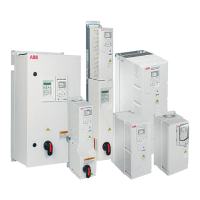conjunction with UL/IEC 60947-4-1. The standards allow for motor overload protection
without external temperature sensors.
The protection feature allows the user to specify the class of operation in the same
manner as the overload relays are specified in standards UL/IEC 60947-4-1 and
NEMA ICS 2.
The motor overload protection supports thermal memory retention and speed sensitivity.
For more information, see drive firmware manual.
Protecting the drive against ground faults
The drive is equipped with an internal ground fault protective function to protect the unit
against ground faults in the motor and motor cable. This function is not a personnel
safety or a fire protection feature. See the firmware manual for more information.
■ Residual current device compatibility
The drive is suitable to be used with residual current devices of Type B.
Note: As standard, the drive contains capacitors connected between the main circuit
and the frame. These capacitors and long motor cables increase the ground leakage
current and may cause nuisance faults in residual current devices.
Implementing the emergency stop function
For safety reasons, install the emergency stop devices at each operator control station
and at other operating stations where the emergency stop may be needed. Implement
the emergency stop according to relevant standards.
Note: You can use the Safe torque off function of the drive to implement the Emergency
stop function.
Implementing the Safe torque off function
See The Safe torque off function (page 347).
Implementing an ATEX-certified motor thermal protection
With option +Q971, the drive provides ATEX-certified safe motor disconnection without
contactor using the drive Safe torque off function. To implement the thermal protection
of a motor in explosive atmosphere (Ex motor), you must also:
• use an ATEX-certified Ex motor
• order an ATEX-certified thermistor protection module for the drive (option +L537),
or acquire and install an ATEX-compliant protection relay
• do the necessary connections.
For more information, see:
108 Guidelines for planning the electrical installation

